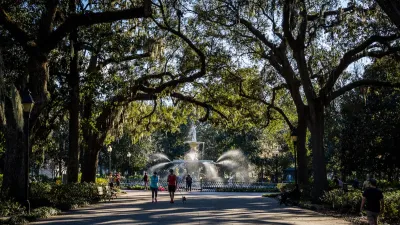The Living Cully coalition prioritizes the well-being of long term, lower-income residents with future-building revitalization projects.

Northeast Portland, Oregon’s largest and ethnically diverse Cully neighborhood is the setting for a case study in community-led efforts to fortify the ability lower-income residents to withstand gentrification and displacement. “Many green infrastructure project teams flounder when trying to couple social justice with their environmental goals, but in Cully green infrastructure provision is linked explicitly with wealth building and anti-displacement goals through a coalition called Living Cully,” reports Barbra Brown Wilson, adapting a chapter from her book Resilience for All.
Living Cully, a collective project of Verde, Native American Youth and Family Center, Habitat for Humanity Portland/Metro East, and Hacienda Community Development Center, was formed to address the lack of infrastructure and services available to Cully residents. Central to their mission is investment “in local residents through leadership development and job training that allow lower-income residents to contribute to positive change in their communities, while also building their own capacity to stay as revitalization occurs,” Brown outlines.
Since the coalition’s formation in 2012, partnering organizations have successfully launched initiatives to champion policies to protect renters, supply affordable housing, develop Cully’s transportation infrastructure, provide job training, and improve community safety. The immediate impact of these efforts is felt widely, but it remains to be seen what long-term effects will remain in terms of “adaptive capacity of resident leaders engaging in these organizing and job-training efforts, the culture change beginning when a generation of youth see walking and biking as important to their community, and the impact of young leaders actualizing many new professional techniques to better their community as part of their middle school skills set.”
FULL STORY: When Green Infrastructure Is an Anti-Poverty Strategy

Alabama: Trump Terminates Settlements for Black Communities Harmed By Raw Sewage
Trump deemed the landmark civil rights agreement “illegal DEI and environmental justice policy.”

Planetizen Federal Action Tracker
A weekly monitor of how Trump’s orders and actions are impacting planners and planning in America.

The 120 Year Old Tiny Home Villages That Sheltered San Francisco’s Earthquake Refugees
More than a century ago, San Francisco mobilized to house thousands of residents displaced by the 1906 earthquake. Could their strategy offer a model for the present?

Ken Jennings Launches Transit Web Series
The Jeopardy champ wants you to ride public transit.

BLM To Rescind Public Lands Rule
The change will downgrade conservation, once again putting federal land at risk for mining and other extractive uses.

Indy Neighborhood Group Builds Temporary Multi-Use Path
Community members, aided in part by funding from the city, repurposed a vehicle lane to create a protected bike and pedestrian path for the summer season.
Urban Design for Planners 1: Software Tools
This six-course series explores essential urban design concepts using open source software and equips planners with the tools they need to participate fully in the urban design process.
Planning for Universal Design
Learn the tools for implementing Universal Design in planning regulations.
Clanton & Associates, Inc.
Jessamine County Fiscal Court
Institute for Housing and Urban Development Studies (IHS)
City of Grandview
Harvard GSD Executive Education
Toledo-Lucas County Plan Commissions
Salt Lake City
NYU Wagner Graduate School of Public Service





























